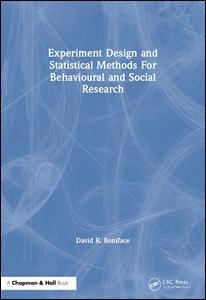Preface, Part One: Statistical Design and Analysis for Basic Experiments, 1 Introduction, 1.1 Structure and scope of Part One, 1.2 Inference for descriptive and experimental research, 1.3 What is experimental research?, 1.4 Theory testing, generalization and cost-effectiveness, 2 Introduction to four basic designs, 2.1 Single-factor independent groups design, 2.2 Single-factor repeated measures design, 2.3 Two-factor design, 2.4 Single-factor independent groups design with use of covariate, 3 Overview of concepts and techniques, 3.1 Variance, 3.2 Variance of means, 3.3 Random sampling and randomization, 3.4 Confidence intervals, 3.5 Sampling fluctuation and sampling error, 3.6 Statistical significance, 3.7 Formulating decision-rnaking as a test of hypotheses, 3.8 Power, 3.9 Sensitivity, 3.10 Efficiency, 3.11 Bias, 3.12 Logistical constraints, 4 Single-factor independent groups design, 4.1 Introduction, 4.2 The principles of the analysis of variance, 4.3 Analysis of variance and significance test, 4.4 The summary table and the decomposition of the total SS, 4.5 Computational formulae for degrees of freedom and SSs, 4.6 Underlying model and assumptions for tests of significance, 4.7 Concept linkage for analysis of variance, 4.8 Exercises, 5 Single-factor repeated measures design, 5.1 Introduction, 5.2 Variation present in the repeated measures design, 5.3 The principles of the analysis of variance, 5.4 Analysis of variance and significance test, 5.5 Computational formulae for SS and degrees of freedom, 5.6 Underlying model and assumptions for tests of significance, 5.7 Exercises, 6 Two-factor independent groups design, 6.1 Introduction, 6.2 Example of two-factor design, 6.3 The effect of the interaction of the factors, 6.4 The principles of the analysis of variance, 6.5 The summary table and tests of significance, 6.6 Formulae for hand calculation of SSs, 6.7 Underlying model and assumptions for tests of significance, 6.8 Exercises, 7 Single-factor independent groups design with covariate, 7.1 Introduction, 7.2 The concept and technique of covariate adjustment, 7.3 The effect of covariate adjustment on variance estimates, 7.4 Underlying model and assumptions for tests of significance, 7.5 Exercises, 8 Contrasts and comparisons among means, 8.1 Introduction, 8.2 Formulating and testing a comparison among means, 8.3 A posteriori tests of comparisons, 8.4 Overview of decisions for contrasts and comparisons of means, 8.5 Exercises, 9 Power and sensitivity in design decisions, 9.1 Introduction, 9.2 Sensitivity and efficiency gains from a continuous covariate, 9.3 Sensitivity and efficiency gains from a category covariate, 9.4 Choice of sample size, 9.5 Choice of within- or between-subjects design, 9.6 Summary of influences on design decisions, 9.7 Exercises, Part Two: Unbalanced, Non-Randomized and Survey Designs, 10 Unbalanced and confounded designs, 10.1 Introduction, 10.2 Two-factor unbalanced design, 10.3 Confounding in one-variable non-randomized designs, 10.4 Exercises, 11 Multiple regression, 11.1 Introduction, 11.2 Overview of designs, variables and orthogonality, 11.3 Comparison of models with category and continuous independent variables, 11.4 Glossary of terms for multiple regression, 11.5 Sequential model construction, 11.6 Exercises, Part Three: Analysis for Further Experiment Designs, 12 Two-factor designs with between- and within-subjects factors, 12.1 Introduction, 12.2 Example of a BW design, 12.3 Example of a WW design, 12.4 Overview of rules for the ANOVA summary table for designs BB, BW and WW, 12.5 Tests of significance for simple effects in BW and WW designs, 12.6 Calculation pro forma for simple effects in two-factor designs, 12.7 Contrasts and comparisons in the BW and WW designs, 12.8 Exercises, 13 Three-factor designs, 13.1 Introduction, 13.2 Example of a BBB design, 13.3 Example of a BBW design, 13.4 Example of a BWW design, 13.5 Summary of rules for analysis of BBB, BBW, BWW and WWW designs, 13.6 Exercises, Appendix A: Hints on use of computer programs, Appendix B: Additional exercises for Chapters 5–13, Appendix C: Solutions to exercises for Chapters 4–13, Appendix D: Approximate degrees of freedom for test of significance for simple effects in BW and WW designs, Appendix E: Rationale for approximate sample size formula, Appendix F: Tables of critical values, References, Index




